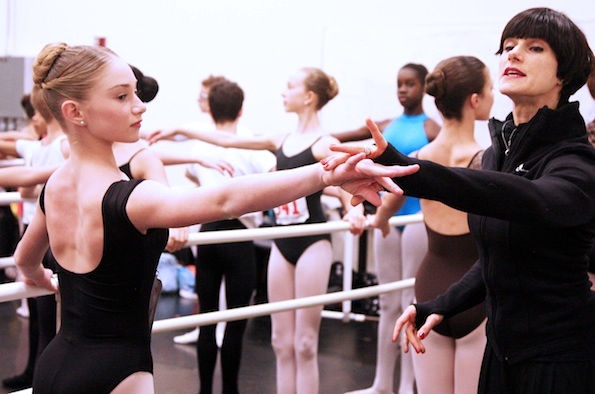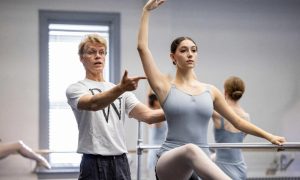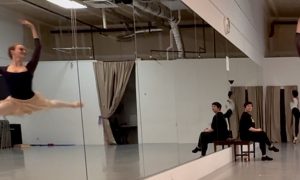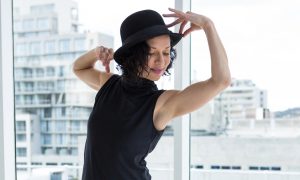By Chelsea Thomas of Dance Informa.
ADC|IBC will celebrate its 10th Anniversary Season in Spring 2015, and the competition is raising the barre with sizable cash prizes, new events, no more inter-city travel and even more scholarship monies for select competitors. For the first time, dancers can plan for an extra day of dancing as a sixth day was added to the previously five-day event. Plus, ballet enthusiasts can now watch Round I classes streaming live, not just the Round II performances.
Discussing the upcoming season, Audrianna Broad, founder and president of ADC|IBC, said, “It’s a huge milestone! I can’t say it’s a surprise because it’s something that we work very hard on to achieve, but I think it’s exciting. I think everyone involved and others in the larger ballet world are seeing the value in ADC|IBC and what the kids are getting out of it.”
The Florida-based competition, which launched in 2005, now sees more than 600 dancers compete each season. It first came together when Broad, a former dancer with Orlando Ballet, decided to meld her ballet experience with her economics and investments education. A decade later, ADC|IBC awards more than $75,000 in scholarships and prizes every year, giving talented young dancers a strong backing as they seek further professional opportunities.
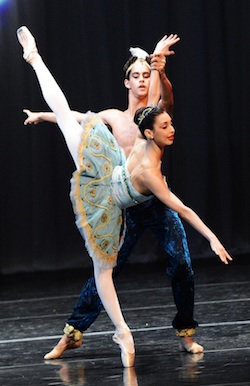
Junior ADC|IBC Grand Prix Award Winner Gabriella Stilo (age 14) with Francisco Serrano, the 2013 Fernando Bujones Recipient and Gold Medalist, who is now with the Royal Ballet School. Copyright: Mark W. Miller.
“We’ll have everything we’ve had in the past this season, which is quite a significant roster of opportunities from our partner schools,” Broad said. “We have one of the largest sources of funding in ballet competitions right now and we’re working on really honing in on top-tier companies for our most talented competitors.”
Partnering schools, companies and intensives include Ajkun Ballet Theatre, Atlanta Ballet, BalletMet Columbus, Ballet West, Boston International Ballet Intensive (hosted by Koltun Ballet Academy), Ellison Ballet, Hubbard Street Dance Chicago, Joffrey Ballet School, Louisville Ballet, Orlando Ballet, Rock School for Dance Education, Sarasota Ballet and Tulsa Ballet.
In addition to these connections, one of the ways ADC|IBC stands out is its reputation for objective, non-biased judging. Dancers of all nationalities, ages 7-21, will be judged equally, explains Broad.
“For sure, the biggest comment that I get back is how fair the competition is. I guess compared to other prior experiences somewhere else, dancers and their supporters are impressed by our equality and objectivity. That’s a big reason why our numbers are continuing to grow I think. Dancers are returning in high rates and we’re continuing to bring in new faces,” she said.
ADC|IBC has always employed a more pedagogical than competitive approach too. The focus is generally not on participants beating fellow dancers or on avoiding elimination, but rather, them earning the highest score and remaining in the competition as long as possible. Round I is focused on pre-screening dancers via in-studio classes and teaching them variations, while Round II moves to the theatre for the competitors to present their solos.
“The first two days will be allocated to Round I, which is a differentiating factor in our whole set-up as a competition. Compared to other ballet competitions, especially pre-professional ballet competitions, we focus on classwork and compulsory variations in classical and contemporary. The dancers learn the variations when they are there after they check in, not beforehand,” Broad explained.
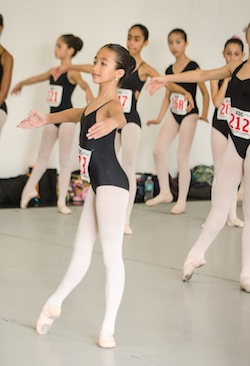
Isabella Castillo, a dancer from Pointe Centro de Danzas of the Republic of Panama, which was named the 2014 Outstanding School. Copyright: SSP.
“They go through the technique and variations and learn it before later performing it in the studio for the judges. At that point, they are evaluated in all those aspects and the judges come to a conclusive, preliminary score for each competitor. While no one is eliminated in this round, it helps sort the dancers according to rankings as they head into Round II. It gives the dancers an idea of where they are in the rankings overall so they can know how hard to push in Round II,” Broad continued.
Round II, which takes place in a state-of-the-art theatre in Downtown Daytona Beach, allows dancers to perform their own classical and contemporary solos, plus duos, trios or group work for the Ensemble Division.
“This competition segment rolls on for four days straight,” Broad noted. “As that’s happening in the theatre, we also have classes consistently running downstairs. This allows dancers more opportunities to work with our master faculty. Plus, more scholarships are offered through those classes as well.”
Former ADC|IBC competitors now dance all over the world and in various styles. Noteworthy alumni include Asia Bui (currently with Houston Ballet), Christopher Revels (a principal with Los Angeles Ballet) and Chehon Wespi-Tschopp (So You Think You Can Dance Season 9 winner who danced on the Come Fly Away by Twyla Tharp national tour.) Some currently unannounced alumni will return for the 10th Anniversary Season to perform in the annual Gala.
Looking to the future of the competition, Broad notes that the organization hopes to continue bringing in prestigious judges (past judges have included artistic directors, former principal dancers and deans of ballet schools) and expanding its international reach. Right now 40 percent of the competitors come from cities outside of the U.S., with many dancers travelling from China and Brazil.
“Just this year, the Chinese government mandated support for ADC|IBC for all participating ballet academies in their country. My Chinese team director made that possible, which was a huge deal for us,” Broad noted.
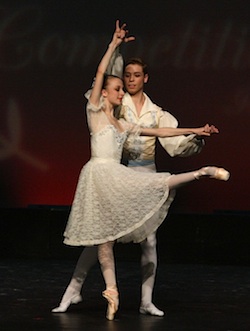
ADC|IBC alumni Alberto Blanco and Ashley Baszto, now dancers with Orlando Ballet, in 2013 competition. Copyright: SSP.
Also, if the competition continues to grow at the rate that it is, Broad and other event officials will consider changing the selection process.
She added, “Another thing is that we’re trying to give more power and weight to the actual dancers themselves when it comes to professional advancement… For lack of a better term, we’re trying to give them a brand. Yes, the competition is fun and educational, but we also want them to use it as a tool… I guess the best way to describe it is that we’re building them a fan base from an early age on.
Broad noted that if dancers were to build their “brand” from 10 to 17 years old (every time they compete) then by the time they’re auditioning for professional positions the companies might not only want to hire them because they’re talented but “because they have better name recognition and a fan base.” Companies often sell more seats if their dancers are better known public figures.
Yet, even with all these new concepts, ideas and additions to the competition, ADC|IBC keeps its central focus – to attract and cultivate professionally driven participants and help them launch successful dance careers.
“Whatever direction it is that we’re leading in, it seems that’s what the dancers, the parents and the teachers are looking for. And I think for myself and the others I work closely with that going into the 10th year is a good reminder to keep doing what we’re doing and to keep an open dialogue with our attendees,” Broad said.
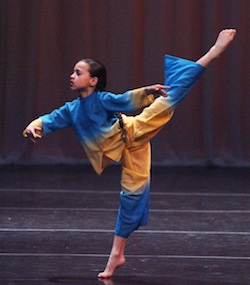
ADC|IBC’s youngest age division (ages 7-11) has the highest percentage of international competitors. This dancer, eight-year-old Martina Miro, is a representative of Spain. Copyright: SSP.
“To stay competitive in the next decade for us is to be able to speak their language and provide what they need in the changing ballet environment. I think that’s going to be crucial for us as we move onward.”
Registration opens for U.S. dancers on November 3. The video applications open online for international dancers on September 29. The 2015 competition is set for March 17-22.
New cash prizes range from $500 for 1st Place in the Primary Division to $2,500 for 1st Place in the Senior Division. Judges, faculty members and guest performers are expected to be announced in January 2015.
For more information, visit www.adcibc.com.
Photo (top): Master Teacher Alexandra Koltun (a former Boston Ballet principal) with 2014 Junior Gold Medalist in Classical Ballet Female Division, Maggie Chadbourne, during Scholarship Expo Classes. Copyright: SSP.


